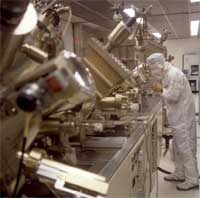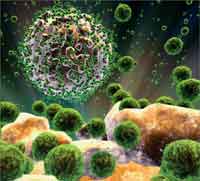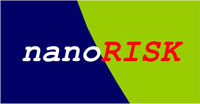Showing Spotlights 73 - 80 of 87 in category All (newest first):
 Freshwater looks like it will become the oil of the 21st century - scarce, expensive and fought over. While over 70 per cent of the Earth's surface is covered by water, most of it is unusable for human consumption. According to the Government of Canada's Environment Department (take a look at their Freshwater Website - a great resource for facts and all kinds of aspects about water), freshwater lakes, rivers and underground aquifers represent only 2.5 per cent of the world's total freshwater supply. Unfortunately, in addition to being scarce, freshwater is also very unevenly distributed. The United Nations has compared water consumption with its availability and has predicted that by the middle of this century between 2 billion and 7 billion people will be faced with water scarcity. It gets worse: In the developing countries, 80 per cent of illnesses are water-related. Due to the shortage of safe drinking water in much of the world, there are 3.3 million deaths every year from diarrheal diseases caused by E. coli, salmonella and cholera bacterial infections, and from parasites and viral pathogens. In fact, between 1990 and 2000, more children died of diarrhea than all the people killed in armed conflicts since the Second World War. The use of nanotechnologies in four key water industry segments - monitoring, desalinization, purification and wastewater treatment - could play a large role in averting the coming water crisis. But hoping that the 'magic' of nanotechnology will solve all water problems is naive - the basic problems of accessibility to technologies, affordability, and fair distribution still need to be solved.
Freshwater looks like it will become the oil of the 21st century - scarce, expensive and fought over. While over 70 per cent of the Earth's surface is covered by water, most of it is unusable for human consumption. According to the Government of Canada's Environment Department (take a look at their Freshwater Website - a great resource for facts and all kinds of aspects about water), freshwater lakes, rivers and underground aquifers represent only 2.5 per cent of the world's total freshwater supply. Unfortunately, in addition to being scarce, freshwater is also very unevenly distributed. The United Nations has compared water consumption with its availability and has predicted that by the middle of this century between 2 billion and 7 billion people will be faced with water scarcity. It gets worse: In the developing countries, 80 per cent of illnesses are water-related. Due to the shortage of safe drinking water in much of the world, there are 3.3 million deaths every year from diarrheal diseases caused by E. coli, salmonella and cholera bacterial infections, and from parasites and viral pathogens. In fact, between 1990 and 2000, more children died of diarrhea than all the people killed in armed conflicts since the Second World War. The use of nanotechnologies in four key water industry segments - monitoring, desalinization, purification and wastewater treatment - could play a large role in averting the coming water crisis. But hoping that the 'magic' of nanotechnology will solve all water problems is naive - the basic problems of accessibility to technologies, affordability, and fair distribution still need to be solved.
Aug 15th, 2007
 Having just re-read Richard Feynman's 20-year old autobiography titled Surely You're Joking, Mr. Feynman! (Adventures of a Curious Character) I thought it makes for a great little Nanowerk Spotlight leading into the weekend - and it won't be about nanotechnology. Feynman's 1959 lecture "Plenty of room at the bottom" is probably the most famous and most quoted physics speech ever and it is the one thing that most non-scientists associate with his name. Feynman, who received the Nobel Prize in Physics in 1965 for his work on on quantum electrodynamics, participated in the Manhattan Project and was a member of the panel that investigated the Space Shuttle Challenger disaster in 1986. He taught physics, first at Cornell and later at the California Institute of Technology. In typical Feynman fashion, a major factor in his decision of chosing CalTech over other institutions was a desire to live in a mild climate, a goal he chose while having to put snow chains on his car's wheels in the middle of a snowstorm in Ithaca, New York. What makes this book such a gem is the weird and wacky collection of anecdotes that Feynman serves up when leading us through his childhood, education and career. Whether he learns how to pick locks and crack safes, plays the bongo drums in an orchestra, gets a commission to paint a naked female toreadore, or competes in a samba competition during Carnival in Rio, the book is not about physics, but the physicist. Underneath all these hilarious stories, though, are recurring leitmotifs of curiosity, tenacity, and total disrespect for ideas that have no grounding in science. For everyone who is quoting Feynman's speech, or who is reading it, this autobiography goes a long way explaining the unconventional mind behind his revolutionary ideas.
Having just re-read Richard Feynman's 20-year old autobiography titled Surely You're Joking, Mr. Feynman! (Adventures of a Curious Character) I thought it makes for a great little Nanowerk Spotlight leading into the weekend - and it won't be about nanotechnology. Feynman's 1959 lecture "Plenty of room at the bottom" is probably the most famous and most quoted physics speech ever and it is the one thing that most non-scientists associate with his name. Feynman, who received the Nobel Prize in Physics in 1965 for his work on on quantum electrodynamics, participated in the Manhattan Project and was a member of the panel that investigated the Space Shuttle Challenger disaster in 1986. He taught physics, first at Cornell and later at the California Institute of Technology. In typical Feynman fashion, a major factor in his decision of chosing CalTech over other institutions was a desire to live in a mild climate, a goal he chose while having to put snow chains on his car's wheels in the middle of a snowstorm in Ithaca, New York. What makes this book such a gem is the weird and wacky collection of anecdotes that Feynman serves up when leading us through his childhood, education and career. Whether he learns how to pick locks and crack safes, plays the bongo drums in an orchestra, gets a commission to paint a naked female toreadore, or competes in a samba competition during Carnival in Rio, the book is not about physics, but the physicist. Underneath all these hilarious stories, though, are recurring leitmotifs of curiosity, tenacity, and total disrespect for ideas that have no grounding in science. For everyone who is quoting Feynman's speech, or who is reading it, this autobiography goes a long way explaining the unconventional mind behind his revolutionary ideas.
Aug 3rd, 2007
 Following up on yesterday's Nanowerk Spotlight on nanobionics, today we'll look at bionics and other nanotechnology applications that could benefit disabled people. A range of applications and products with a combination of nanotechnology, biotechnology, and information technology are under development to directly improve the lives of people with severe injuries or medical conditions. Solutions range from better implants and prosthetics to brain-machine interfaces and they already are in the early stages of development and have working prototypes. While these are technical solutions to medical issues, and also a potential path towards transhumanist dreams, there is a number of social issues surrounding them that are rarely discussed. For instance, some 180 million young people between the ages of 10-24 live with a physical, sensory, intellectual or mental health disability significant enough to make a difference in their daily lives. The vast majority of these young people, some 150 million (80%) live in the developing world. They have limited access to education, employment and basic health care, and generally experience profound economic and social exclusion. The question needs to be asked whether the nano- and biotechnologies discussed to help the developing world are designed in a way to take into account the specific needs and realities of disabled people. Even if they did - and they do not - the next question is whether all these wonderful new technologies are really affordable for developing countries, or in other words: who pays for them? And finally, does the right social framework exist to take advantage of them?
Following up on yesterday's Nanowerk Spotlight on nanobionics, today we'll look at bionics and other nanotechnology applications that could benefit disabled people. A range of applications and products with a combination of nanotechnology, biotechnology, and information technology are under development to directly improve the lives of people with severe injuries or medical conditions. Solutions range from better implants and prosthetics to brain-machine interfaces and they already are in the early stages of development and have working prototypes. While these are technical solutions to medical issues, and also a potential path towards transhumanist dreams, there is a number of social issues surrounding them that are rarely discussed. For instance, some 180 million young people between the ages of 10-24 live with a physical, sensory, intellectual or mental health disability significant enough to make a difference in their daily lives. The vast majority of these young people, some 150 million (80%) live in the developing world. They have limited access to education, employment and basic health care, and generally experience profound economic and social exclusion. The question needs to be asked whether the nano- and biotechnologies discussed to help the developing world are designed in a way to take into account the specific needs and realities of disabled people. Even if they did - and they do not - the next question is whether all these wonderful new technologies are really affordable for developing countries, or in other words: who pays for them? And finally, does the right social framework exist to take advantage of them?
Jul 18th, 2007
 New technology, whether it is a novel cancer treatment or an innovative approach to farming, almost always comes with risk. Those risks are often first - and most severely - felt by industry workers, and nanotechnology is no different. Today, workers around the world are exposed to nanoparticles on a daily basis. There is much speculation, yet so far, little definitive information about how exposure affects workers. A report released by the International Council on Nanotechnology in November 2006, offers a clear picture of the situation. "The properties for which novel nanoscale materials are designed may generate new risks to workers, consumers, the public, and the environment. While some of these risks can be anticipated from experiences with other synthetic chemicals and with existing knowledge of ambient and manufactured fine particles, novel risks associated with new properties cannot easily be anticipated based on existing data." Questions, such as how to measure toxicity and how to monitor and control exposure, remain unanswered.
New technology, whether it is a novel cancer treatment or an innovative approach to farming, almost always comes with risk. Those risks are often first - and most severely - felt by industry workers, and nanotechnology is no different. Today, workers around the world are exposed to nanoparticles on a daily basis. There is much speculation, yet so far, little definitive information about how exposure affects workers. A report released by the International Council on Nanotechnology in November 2006, offers a clear picture of the situation. "The properties for which novel nanoscale materials are designed may generate new risks to workers, consumers, the public, and the environment. While some of these risks can be anticipated from experiences with other synthetic chemicals and with existing knowledge of ambient and manufactured fine particles, novel risks associated with new properties cannot easily be anticipated based on existing data." Questions, such as how to measure toxicity and how to monitor and control exposure, remain unanswered.
Jul 9th, 2007
 Having written in this space about the (possibly) good and the (possibly) bad of food nanotechnology before, here is now a scientific approach to assessing how the public perceives nanotechnology in food and food packaging. Swiss social psychologist Michael Siegrist has looked into the issues of trust, risk and the public acceptance of nanotechnology before. Now, he and his colleagues have taken the area of nanofoods and tried to understand what factors influence the willingness to buy food that has been produced, processed or packaged with nanotechnology. Their conclusion: Perceived benefits seems to be the most important predictor for willingness to buy.
Having written in this space about the (possibly) good and the (possibly) bad of food nanotechnology before, here is now a scientific approach to assessing how the public perceives nanotechnology in food and food packaging. Swiss social psychologist Michael Siegrist has looked into the issues of trust, risk and the public acceptance of nanotechnology before. Now, he and his colleagues have taken the area of nanofoods and tried to understand what factors influence the willingness to buy food that has been produced, processed or packaged with nanotechnology. Their conclusion: Perceived benefits seems to be the most important predictor for willingness to buy.
May 8th, 2007
 For centuries, man has searched for miracle cures to end suffering caused by disease and injury. Many researchers believe nanotechnology may be mankind's first "giant step" toward this goal. Whether these beliefs are based on facts or hope, many corporations and governments are willing to invest a great deal of money to find out what happens when nanotechnology is used for medical applications - the emerging field of nanomedicine. Hundreds of millions, if not billions of dollars have been invested by governments, such as the U.S. National Cancer Institute, and the private sector in nanomedicine research and nanotech-related life sciences ventures. The 2008 budget of the U.S. National Nanotechnology Initiative provides more than $200 million for the National Institutes of Health. The European Union, particularly Germany and the UK, and Japan are also investing heavily in this field. It is difficult to find fault with a technology that promises to cure cancer almost before it starts and prevent the spread of AIDS and other infectious diseases. Scientists around the globe are searching for ways to exploit nanoparticles to improve human health. However, there are toxicological concerns and ethical issues that come with nanomedicine and they have to be addressed alongside the benefits.
For centuries, man has searched for miracle cures to end suffering caused by disease and injury. Many researchers believe nanotechnology may be mankind's first "giant step" toward this goal. Whether these beliefs are based on facts or hope, many corporations and governments are willing to invest a great deal of money to find out what happens when nanotechnology is used for medical applications - the emerging field of nanomedicine. Hundreds of millions, if not billions of dollars have been invested by governments, such as the U.S. National Cancer Institute, and the private sector in nanomedicine research and nanotech-related life sciences ventures. The 2008 budget of the U.S. National Nanotechnology Initiative provides more than $200 million for the National Institutes of Health. The European Union, particularly Germany and the UK, and Japan are also investing heavily in this field. It is difficult to find fault with a technology that promises to cure cancer almost before it starts and prevent the spread of AIDS and other infectious diseases. Scientists around the globe are searching for ways to exploit nanoparticles to improve human health. However, there are toxicological concerns and ethical issues that come with nanomedicine and they have to be addressed alongside the benefits.
May 7th, 2007
 Experts and the public generally differ in their perceptions of risk. While this might be due to social and demographic factors, it is generally assumed by scientists who conduct risk research that experts' risk assessments are based more strongly on actual or perceived knowledge about a technology than lay people's risk assessments. In the case of nanotechnology, surveys show that most people are not familiar with it. The public perception of an emerging technology will have a major influence on the acceptance of this technology and its commercial success. If the public perception turns negative, potentially beneficial technologies will be severely constrained as is the case for instance with gene technology. It seems plausible that the evaluation of new technologies, such as nanotechnologies, is guided by people's theories and values. For instance, people for whom the technological revolution is associated with positive outcomes - and who are not afraid of possible negative side effects of technological progress - may assess nanotechnology applications more positively than people for whom negative effects outweigh positive effects. Researchers in Switzerland conducted two studies which examined how lay people and experts perceived various nanotechnology applications and how companies address the public's concerns.
Experts and the public generally differ in their perceptions of risk. While this might be due to social and demographic factors, it is generally assumed by scientists who conduct risk research that experts' risk assessments are based more strongly on actual or perceived knowledge about a technology than lay people's risk assessments. In the case of nanotechnology, surveys show that most people are not familiar with it. The public perception of an emerging technology will have a major influence on the acceptance of this technology and its commercial success. If the public perception turns negative, potentially beneficial technologies will be severely constrained as is the case for instance with gene technology. It seems plausible that the evaluation of new technologies, such as nanotechnologies, is guided by people's theories and values. For instance, people for whom the technological revolution is associated with positive outcomes - and who are not afraid of possible negative side effects of technological progress - may assess nanotechnology applications more positively than people for whom negative effects outweigh positive effects. Researchers in Switzerland conducted two studies which examined how lay people and experts perceived various nanotechnology applications and how companies address the public's concerns.
Mar 30th, 2007
 As we reported today in our news coverage, the UK and the U.S. are to work together to develop a global science portal, making scientific information from many countries available via the internet. In contrast to the various national databases that already exist today, the new portal, to be known as "science.world", will build on the U.S. portal science.gov. The project has the goal of making the science offerings of all nations searchable in one global gateway. Given this comprehensive goal, and the rapidly gaining importance and wealth of nanotechnology related information, anything nanotech will have to be a significant part of this new library. One can't help but ask, though, if this effort by various nations' government agencies, led by the U.S. Department of Energy, is tax money well spent. Google, after all, is already developing such a service, called Google Scholar, and it beats all the existing government portals hands down.
As we reported today in our news coverage, the UK and the U.S. are to work together to develop a global science portal, making scientific information from many countries available via the internet. In contrast to the various national databases that already exist today, the new portal, to be known as "science.world", will build on the U.S. portal science.gov. The project has the goal of making the science offerings of all nations searchable in one global gateway. Given this comprehensive goal, and the rapidly gaining importance and wealth of nanotechnology related information, anything nanotech will have to be a significant part of this new library. One can't help but ask, though, if this effort by various nations' government agencies, led by the U.S. Department of Energy, is tax money well spent. Google, after all, is already developing such a service, called Google Scholar, and it beats all the existing government portals hands down.
Feb 20th, 2007
 Freshwater looks like it will become the oil of the 21st century - scarce, expensive and fought over. While over 70 per cent of the Earth's surface is covered by water, most of it is unusable for human consumption. According to the Government of Canada's Environment Department (take a look at their Freshwater Website - a great resource for facts and all kinds of aspects about water), freshwater lakes, rivers and underground aquifers represent only 2.5 per cent of the world's total freshwater supply. Unfortunately, in addition to being scarce, freshwater is also very unevenly distributed. The United Nations has compared water consumption with its availability and has predicted that by the middle of this century between 2 billion and 7 billion people will be faced with water scarcity. It gets worse: In the developing countries, 80 per cent of illnesses are water-related. Due to the shortage of safe drinking water in much of the world, there are 3.3 million deaths every year from diarrheal diseases caused by E. coli, salmonella and cholera bacterial infections, and from parasites and viral pathogens. In fact, between 1990 and 2000, more children died of diarrhea than all the people killed in armed conflicts since the Second World War. The use of nanotechnologies in four key water industry segments - monitoring, desalinization, purification and wastewater treatment - could play a large role in averting the coming water crisis. But hoping that the 'magic' of nanotechnology will solve all water problems is naive - the basic problems of accessibility to technologies, affordability, and fair distribution still need to be solved.
Freshwater looks like it will become the oil of the 21st century - scarce, expensive and fought over. While over 70 per cent of the Earth's surface is covered by water, most of it is unusable for human consumption. According to the Government of Canada's Environment Department (take a look at their Freshwater Website - a great resource for facts and all kinds of aspects about water), freshwater lakes, rivers and underground aquifers represent only 2.5 per cent of the world's total freshwater supply. Unfortunately, in addition to being scarce, freshwater is also very unevenly distributed. The United Nations has compared water consumption with its availability and has predicted that by the middle of this century between 2 billion and 7 billion people will be faced with water scarcity. It gets worse: In the developing countries, 80 per cent of illnesses are water-related. Due to the shortage of safe drinking water in much of the world, there are 3.3 million deaths every year from diarrheal diseases caused by E. coli, salmonella and cholera bacterial infections, and from parasites and viral pathogens. In fact, between 1990 and 2000, more children died of diarrhea than all the people killed in armed conflicts since the Second World War. The use of nanotechnologies in four key water industry segments - monitoring, desalinization, purification and wastewater treatment - could play a large role in averting the coming water crisis. But hoping that the 'magic' of nanotechnology will solve all water problems is naive - the basic problems of accessibility to technologies, affordability, and fair distribution still need to be solved.
 Subscribe to our Nanotechnology Spotlight feed
Subscribe to our Nanotechnology Spotlight feed





